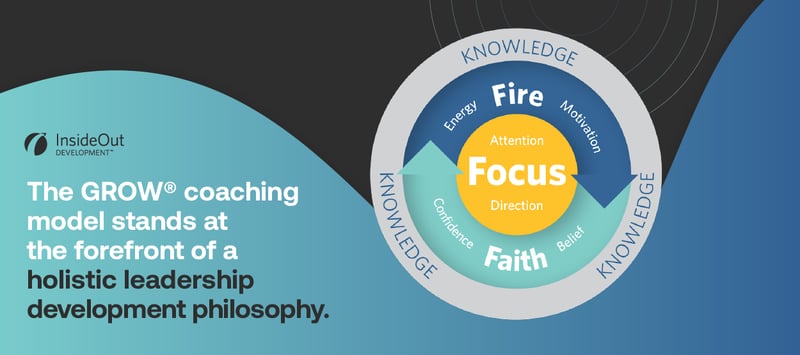As your business grows and evolves, the ability to cultivate and nurture future leaders becomes a strategic move that benefits both the short- and long-term well-being of your company.

A well-developed leadership structure, therefore, is an investment in your business. Without it, your organization may not have the talent and skills to thrive in the long run.
In this blog, we’ll explore the significance of leadership development coaching and how the GROW® model supports this initiative, providing you with practical strategies for identifying, nurturing, and empowering emerging leaders within your business.
Importance of Leadership Development
When leaders prioritize the development and well-being of their teams, it creates a positive ripple effect that boosts morale, job satisfaction, and, ultimately, performance.
A high-performance culture is one where employees and team members are driven and inspired to excel. They collaborate effectively, encourage one another, and continuously strive for improvement. When this energy is coupled with a culture of coaching, the environment breeds growth and empowers everyone to reach their maximum potential.
Another significant outcome of a strong coaching culture is its ability to nurture learning mindsets.
When equipped with coaching skills, leaders become catalysts for both individual and team development, driving heightened performance and increasing adaptability, innovation, and collaboration. This helps to achieve short-term goals but also sets the stage for sustained growth and success.

One thing to note: Effective leadership is also intrinsically linked to employee engagement. Employees who are fully engaged and excited about their work are more likely to be committed, productive, and take initiative when needed.
Since a coaching culture naturally promotes open communication, active listening, and meaningful feedback, teams become more engaged as a byproduct.
Identifying Potential Leaders
Being a leader is more than just a title; it's a dynamic role that, when performed correctly, maximizes the potential of everyone under its wing.
When choosing who to place in leadership roles, you need to assess a person’s potential and identify the qualities that will set them up for success. The first step is recognizing individuals who naturally exhibit the characteristics that define a true leader. Then, you can help nurture these traits and support them in becoming true leaders.
Let's delve into three key characteristics that serve as tell-tale signs of leadership potential.
Initiative and Accountability
It can often be easy to spot a potential leader: They’re the ones who consistently take initiative and approach any task with a sense of accountability. They’re the individuals who don't wait for instructions but take it upon themselves to identify opportunities, act on them, and determine how to respond to any challenges that arise.
Leaders-in-the-making also demonstrate a keen sense of responsibility for their actions. Their ability to drive projects forward and take ownership of both successes and setbacks sets them apart from those who merely show up and do only what’s required.
Strong Communication Skills
Potential leaders often possess the ability to articulate ideas clearly. They actively listen to others and convey complex information in a way that resonates with their team. They inspire confidence through their words and create an environment where open dialogue and feedback are welcomed.
These individuals also easily build rapport, and through this are often able to resolve conflicts before they escalate into bigger issues. This characteristic becomes increasingly vital as leaders ascend to higher roles, where effective communication and motivation are essential for the alignment of every part of an organization.
Problem-Solving Abilities
Those with leadership development potential not only identify challenges but approach them with a solution-oriented mindset. They view problems as opportunities for growth and innovation rather than annoying obstacles that get in the way of day-to-day operations.
Problem-solving abilities help potential leaders guide their teams through difficult situations and uncertain times. This characteristic not only contributes to the success of current projects but lays the foundation for adaptive leadership in the face of challenges, which will always arise no matter what industry you are in.
By identifying potential leaders and cultivating these traits within your organization, you set up an environment where capable leaders can thrive and contribute to a culture of innovation, collaboration, and continuous improvement.
Tools for Assessing Leadership Potential
To support those with leadership potential, an organization needs reliable tools to help evaluate the best candidates for leadership development. Here are three invaluable tools to assess leadership potential.
Performance Reviews
Performance reviews are a fundamental tool for assessing employee performance and leadership potential.
These structured evaluations provide managers with an opportunity to assess someone’s accomplishments, contributions, and passions. Is the person excited about their work? Are they ready and willing to take on tasks and responsibilities?
By incorporating leadership-specific criteria into performance reviews, you can identify emerging leaders more effectively within an already existing framework. But performance reviews shouldn’t be limited to only once a year.

Instead, implement an ongoing culture of coaching so that feedback and support become part of the daily routine and performance review anxiety is diminished. Prioritizing daily or weekly check-ins, plus giving and asking for feedback, all contribute to a healthy culture of coaching.
360-Degree Feedback
360-degree feedback is a powerful tool that involves input from every perspective in an organization — from peers, subordinates, and supervisors. This approach offers a well-rounded view of someone’s leadership potential by getting feedback from those who interact closely with them and gives deeper insight into a person’s strengths and where they have room to improve.
Leadership Competency Assessments
Leadership competency assessments are designed to evaluate specific skills for the most effective leadership. They typically focus on key leadership aspects like communication, decision-making, strategic thinking, and emotional intelligence.
The insights you gain from these assessments help guide current leaders in determining which employees may have the talent, characteristics, and drive to step into a leadership role. Individuals who show promise can be further developed into effective leaders with programs like Ready to GROW and Breakthroughs.
Nurturing Leadership Potential
At InsideOut Development, we believe in a transformative approach to leadership development. It shouldn’t be just a one-off training session or a weekend-long seminar; leadership development is a continuous process that takes a holistic approach to building relevant skills, increasing self-awareness, and improving personal leadership characteristics.
Let’s discuss a few ways to foster holistic leadership development with ongoing education opportunities and other strategies.
Providing Challenging Assignments and Opportunities for Growth
Recognizing leadership potential requires exposing candidates to challenging assignments that push them beyond their comfort zones.
By deliberately providing them with growth opportunities, organizations can identify potential leaders and see how they apply their skills in real-world scenarios. This helps not only to scope out who would best fit into a leadership role but also helps team members work on their leadership skills at the same time.
Mentorship Programs
Mentorship programs play an important role in leadership development because they provide individuals with the guidance and insights needed to form a truly supportive environment. With their wealth of experience, mentors serve as trusted advisors to those who have a desire to develop their leadership skills.
Effective mentorship always begins with thoughtful matching of mentors with mentees. It’s important to connect these individuals based on their shared goals and compatible communication styles. This helps reduce friction or disagreements caused by the partnering of people whose visions don’t align.
Training and Development Opportunities
Leadership potential flourishes through diverse training opportunities such as leadership programs, skill-building workshops, certification courses, and exposure to various learning platforms.
These initiatives equip potential leaders with the knowledge, tools, and perspectives necessary for stepping into roles with greater responsibilities. For example, many InsideOut Development events and workshops are tailored to evolving leadership needs, facilitating a seamless transition into leadership roles.
A Holistic Approach to Bringing Out High Performance
The GROW® coaching model — which stands for Goal, Reality, Options, and Way Forward — stands at the forefront of a holistic leadership development philosophy.

GROW® provides a structured and empowering framework for coaching and developing individuals throughout all levels of an organization. The model aligns perfectly with developing leadership potential as it enables individuals to get clear on their goals, identify any challenges, explore strategic options, and commit themselves to taking concrete steps toward growth.
It’s a foundation for anyone who wants to better themselves in all areas of life and works in harmony with other programs and approaches that prioritize self-awareness and communication as leadership training mechanisms.
Succession Planning
Succession planning is a strategic move for organizations that want to see sustained growth and success. Anticipating who will take on leadership roles when current leaders retire or choose to move on is a proactive way to prepare for the future, helps mitigate risks, and ensures that the organization performs well with minimal hiccups.
Developing a Structured Succession Planning Process
A structured succession planning process begins with a thorough assessment of current and future leadership needs. A holistic approach is always best, as it ensures that potential leaders receive the right training, mentorship, and experience needed to thrive when they move into the leadership role.
Identify the key roles before prioritizing any training. This way, you can tailor your development plans to meet specific leadership requirements. The ultimate goal here is to ensure a smooth and seamless leadership transition, which helps to instill confidence in the organization, employees, and stakeholders.
Succession planning is not just about filling leadership gaps when they occur, however. It's creating a strong foundation for sustained growth by finding people who truly care and are passionate about supporting and leading others.
A culture of leadership development thrives on using strategic tools like the GROW® coaching model, as they enable organizations to build a supportive framework that aligns with their values and cultivate a group of capable leaders who are prepared to face tomorrow’s challenges.
Building Today’s Leaders for Tomorrow’s Success
Nurturing leadership potential is more than just a strategic move to find new leaders; it's a necessity for the long-term success of any organization. Investing in leadership development, then, becomes a non-negotiable. Coaching, mentorship, and structured programs help develop leaders into supportive, capable individuals who help everyone within the organization thrive.
If you’re ready to set your organization up for long-term growth and success and unleash the potential within your team, take a look through the Creating a Coaching Culture eBook. It’ll help you create better accountability, increase employee engagement, and build a resilient company culture ready to tackle every challenge head-on.





